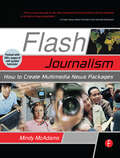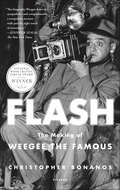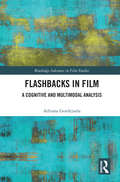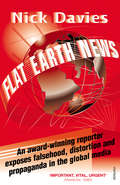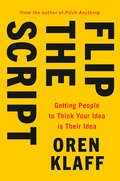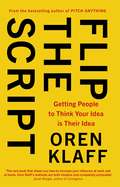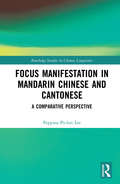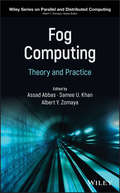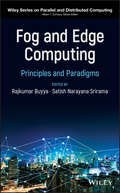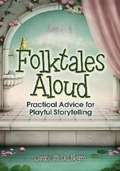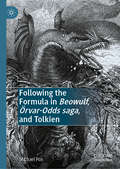- Table View
- List View
Flash Journalism: How to Create Multimedia News Packages
by Mindy McAdamsThis book will assist journalists and Flash developers who are working together to bring video, audio, still photos, and animated graphics together into one complete Web-based package.This book is not just another Flash book because it focuses on the need of journalists to tell an accurate story and provide accurate graphics. This book will illustrate how to animate graphics such as maps, illustrations, and diagrams using Flash. It will show journalists how to integrate high-quality photos and audio interviews into a complete news package for the Web.Each lesson in the book is followed by a learning summary so that journalists can review the skills they have acquired along the way. In addition, the book's six case studies will allow readers to study the characteristics of news packages created with Flash by journalists and Web developers at The Washington Post, MSNBC.com, and Canadian and European news organizations.
Flash: The Making of Weegee the Famous
by Christopher BonanosWinner of the National Book Critics Circle AwardThe first comprehensive biography of Weegee—photographer, “psychic,” ultimate New Yorker—from Christopher Bonanos, author of Instant: The Story of Polaroid.Arthur Fellig’s ability to arrive at a crime scene just as the cops did was so uncanny that he renamed himself “Weegee,” claiming that he functioned as a human Ouija board. Weegee documented better than any other photographer the crime, grit, and complex humanity of midcentury New York City. In Flash, we get a portrait not only of the man (both flawed and deeply talented, with generous appetites for publicity, women, and hot pastrami) but also of the fascinating time and place that he occupied.From self-taught immigrant kid to newshound to art-world darling to latter-day caricature—moving from the dangerous streets of New York City to the celebrity culture of Los Angeles and then to Europe for a quixotic late phase of experimental photography and filmmaking—Weegee lived a life just as worthy of documentation as the scenes he captured. With Flash, we have an unprecedented and ultimately moving view of the man now regarded as an innovator and a pioneer, an artist as well as a newsman, whose photographs are among most powerful images of urban existence ever made.
Flashbacks in Film: A Cognitive and Multimodal Analysis (Routledge Advances in Film Studies)
by Adriana GordejuelaFlashbacks in Film examines fi lm fl ashback as a rich multimodal narrative device, analyzing the cognitive underpinnings of fi lm fl ashbacks and the mechanisms that lead viewers to successfully comprehend them. Combining a cognitive fi lm theory approach with the theoretical framework proposed by blending theory, which claims that human beings’ general ability for conceptual integration underlies most of our daily activities, this book argues that fl ashbacks make sense to the viewer, as they are specifi cally designed for the viewer’s cognitive understanding. Through a mixture of analysis and dozens of case studies, this book demonstrates that successful fi lm fl ashbacks appeal to the spectator’s natural perceptual and cognitive abilities, which spectators exercise daily. This book will serve as a valuable resource for scholars interested in film studies, media studies, and cognitive linguistics.
Flat Earth News: An Award-winning Reporter Exposes Falsehood, Distortion and Propaganda in the Global Media
by Nick DaviesDoes ‘fake news’ really exist? Find out from the ultimate insider.After years of working as a respected journalist, Nick Davies, in this shocking exposé, reveals what really goes on behind the scenes of this contentious industry. From a prestigious newspaper that allowed intelligence agencies to plant fiction in its columns, to the newsroom that routinely rejected stories due to racial bias, to the number of papers that accepted cash bribes. Gripping, thought-provoking and revelatory, this is an insider’s look at one of the most tainted professions.‘Meticulous, fair-minded and utterly gripping’ Telegraph‘Powerful and timely...his analysis is fair, meticulously researched and fascinating’ Observer
Flat World Navigation
by Kim Chandler McdonaldFlat World Navigation introduces the new future of work in the 'flattened world' of the new digital attention-based economy, where real connections can be made in seconds across departments, businesses, cultures and countries. Combining the best elements of networking, social media outreach and collaborative techniques, flat world navigation is an essential capability to build and maintain relationships between colleagues, customers and partners. Employees who can transform themselves into flat world navigators, experts in mediating these powerful relationships and bringing the customer into the conversation, will mean the difference between success and failure in business. Flat World Navigation includes exclusive insights and interviews with international business leaders who successfully use flat world navigation skills, such as the Emmy-winning former NBC and Wall Street Journal reporter Kare Anderson, Sandy Carter at IBM, Gordon Feller at CISCO Systems, Aria Finger at DoSomething.org, Louise Guido at ChangeCorp, Jeffrey A. Finkle at the International Economic Development Council and Carolyn Lawrence, CEO of Women of Influence. This book is grounded in real-world experience with insights and advice to build your skills base and empower the next generation of business people. Additionally, it is of great use to business owners and managers looking to effectively leverage the skills of these flat world navigators, whose critical role brings attention to ideas, products and services and, as such, must be part of a successful business strategy.
Flexible Resources for Smart Cities
by M. Hadi Amini Miadreza Shafie-KhahThis book paves the road for researchers from various areas of engineering working in the realm of smart cities to discuss the intersections in these areas when it comes to infrastructure and its flexibility. The authors lay out models, algorithms and frameworks related to the ‘smartness’ in the future smart cities. In particular, manufacturing firms, electric generation, transmission and distribution utilities, hardware and software computer companies, automation and control manufacturing firms, and other industries will be able to use this book to enhance their energy operations, improve their comfort and privacy, as well as to increase the benefit from the electrical system. The book pertains to researchers, professionals, and R&D in an array of industries.
Flip the Script: Getting People to Think Your Idea Is Their Idea
by Oren KlaffTHE BESTSELLING AUTHOR OF PITCH ANYTHING IS BACK TO FLIP YOUR ENTIRE APPROACH TO PERSUASION.Is there anything worse than a high-pressure salesperson pushing you to say "yes" (then sign on the dotted line) before you're ready?If there's one lesson Oren Klaff has learned over decades of pitching, presenting, and closing long-shot, high-stakes deals, it's that people are sick of being marketed and sold to. Most of all, they hate being told what to think. The more you push them, the more they resist.What people love, however, is coming up with a great idea on their own, even if it's the idea you were guiding them to have all along. Often, the only way to get someone to sign is to make them feel like they're smarter than you.That's why Oren is throwing out the old playbook on persuasion. Instead, he'll show you a new approach that works on this simple insight: Everyone trusts their own ideas. If, rather than pushing your idea on your buyer, you can guide them to discover it on their own, they'll believe it, trust it, and get excited about it. Then they'll buy in and feel good about the chance to work with you.That might sound easier said than done, but Oren has taught thousands of people how to do it with a series of simple steps that anyone can follow in any situation.And as you'll see in this book, Oren has been in a lot of different situations.He'll show you how he got a billionaire to take him seriously, how he got a venture capital firm to cough up capital, and how he made a skeptical Swiss banker see him as an expert in banking. He'll even show you how to become so compelling that buyers are even more attracted to you than to your product. These days, it's not enough to make a great pitch.To get attention, create trust, and close the deal, you need to flip the script.
Flip the Script: Getting People to Think Your Idea is Their Idea
by Oren KlaffThis book will change the way you think about persuasion, and have you closing deals in no time.These days, it's just not enough to make a great pitch. Over decades of being marketed, pitched, sold (and lied) to, we've grown resistant to sales persuasion. The moment we feel pressured to buy, we pull away. And if we're told what to think, our defences go up. That's why Oren Klaff, bestselling author of Pitch Anything, has devised a new approach to persuasion based on a simple insight: everyone trusts their own ideas. Instead of pushing your idea on your buyer, guide them to discover it on their own and they will get excited about it. They'll buy in and feel good about the chance to work with you. In Flip the Script, Klaff breaks down this insight into a series of actionable steps.You will learn how to:*Achieve Status Alignment: Use a status tip-off, a strategically placed remark that identifies you as an insider who can relate to your client's concerns.*Close the Certainty Gap: Allay your buyer's fears about going into business with you by delivering a flash roll, proving your expertise in the domain.*Present Your Idea as Plain Vanilla: Don't overhype your product as a first-of-its-kind solution. The more you emphasise the familiar, reliable elements of your product, the easier you make it for your buyer to say yes.Packed with examples of the long-shot, often hilarious deals that Klaff has pulled off over the years, Flip the Script is the most entertaining, informative masterclass in dealmaking you'll find anywhere. It will transform your approach to pitching, leaving you fully prepared to raise money, seal deals and keep your cool in the toughest business situations.
Flip the Script: Getting People to Think Your Idea is Their Idea
by Oren KlaffThis book will change the way you think about persuasion, and have you closing deals in no time.These days, it's just not enough to make a great pitch. Over decades of being marketed, pitched, sold (and lied) to, we've grown resistant to sales persuasion. The moment we feel pressured to buy, we pull away. And if we're told what to think, our defences go up. That's why Oren Klaff, bestselling author of Pitch Anything, has devised a new approach to persuasion based on a simple insight: everyone trusts their own ideas. Instead of pushing your idea on your buyer, guide them to discover it on their own and they will get excited about it. They'll buy in and feel good about the chance to work with you. In Flip the Script, Klaff breaks down this insight into a series of actionable steps.You will learn how to:*Achieve Status Alignment: Use a status tip-off, a strategically placed remark that identifies you as an insider who can relate to your client's concerns.*Close the Certainty Gap: Allay your buyer's fears about going into business with you by delivering a flash roll, proving your expertise in the domain.*Present Your Idea as Plain Vanilla: Don't overhype your product as a first-of-its-kind solution. The more you emphasise the familiar, reliable elements of your product, the easier you make it for your buyer to say yes.Packed with examples of the long-shot, often hilarious deals that Klaff has pulled off over the years, Flip the Script is the most entertaining, informative masterclass in dealmaking you'll find anywhere. It will transform your approach to pitching, leaving you fully prepared to raise money, seal deals and keep your cool in the toughest business situations.
Flirting 101: How to Charm Your Way to Love, Friendship, and Success
by Michelle Lia Lewis Andrew BryantEvery party has a stand-out - a guy or gal who breezes into a room and instantly attracts everyone's attention. It's not always about looks or money, so what's their secret? It's all about flirting! A good flirt knows how to make anyone around them feel good, and that's a very powerful skill. Luckily, it is a skill that can be learned. FLIRTING 101 will show you how to:-Discover your inner flirt -Increase your self-confidence -Take advantage of non-verbal communication-Overcome your fear of rejectionAnd much more!Whether you want to attract a life partner, improve business, or just have a little fun, this book is packed with useful tips, stories, practical exercises, and quizzes to help you transform into the most fabulous flirt you can be.
Fluctuation-Induced Network Control and Learning: Applying the Yuragi Principle of Brain and Biological Systems
by Masayuki Murata Kenji LeibnitzFrom theory to application, this book presents research on biologically and brain-inspired networking and machine learning based on Yuragi, which is the Japanese term describing the noise or fluctuations that are inherently used to control the dynamics of a system. The Yuragi mechanism can be found in various biological contexts, such as in gene expression dynamics, molecular motors in muscles, or the visual recognition process in the brain. Unlike conventional network protocols that are usually designed to operate under controlled conditions with a predefined set of rules, the probabilistic behavior of Yuragi-based control permits the system to adapt to unknown situations in a distributed and self-organized manner leading to a higher scalability and robustness.The book consists of two parts. Part 1 provides in four chapters an introduction to the biological background of the Yuragi concept as well as how these are applied to networking problems. Part 2 provides additional contributions that extend the original Yuragi concept to a Bayesian attractor model from human perceptual decision making. In the six chapters of the second part, applications to various fields in information network control and artificial intelligence are presented, ranging from virtual network reconfigurations, a software-defined Internet of Things, and low-power wide-area networks.This book will benefit those working in the fields of information networks, distributed systems, and machine learning who seek new design mechanisms for controlling large-scale dynamically changing systems.
Fluidware: Novel Approaches for Large-Scale IoT Systems (Internet of Things)
by Giancarlo Fortino Franco Zambonelli Mirko Viroli Barbara ReThis book provides an overview of the many approaches that can adopted for programming and deploying highly-adaptive and large-scale IoT systems, with a specific focus on the key results achieved within the Fluidware research project. The authors start by presenting Fluidware, which develops a novel programming model for IoT services and applications, along with the associated and robust large-scale IoT services and applications. Starting from previous findings in the areas of field-based coordination, collective adaptive systems, stream computing and aggregate computing, the authors address the complexity of building modern, large-scale IoT systems, by a full-fledged engineering approach revolving around a new notion of distributed programming. The authors show how the key innovative idea of Fluidware is to abstract collectives of devices of the IoT fabric as sources, digesters, and targets of distributed "flows" of contextualized events, carrying information about data produced and actuating commands. The book is divided into three parts: (i) the first part is a general introduction to the Fluidware ideas and to the key problems associated with programming IoT systems, (ii) the second part presents the key results achieved within the Fluidware project; (iii) the third part identified open challenges and research directions.
Flying Ad Hoc Networks: Cooperative Networking and Resource Allocation (Wireless Networks)
by Chunxiao Jiang Jingjing WangRelying on unmanned autonomous flight control programs, unmanned aerial vehicles (UAVs) equipped with radio communication devices have been actively developed around the world. Given their low cost, flexible maneuvering and unmanned operation, UAVs have been widely used in both civilian operations and military missions, including environmental monitoring, emergency communications, express distribution, even military surveillance and attacks, for example. Given that a range of standards and protocols used in terrestrial wireless networks are not applicable to UAV networks, and that some practical constraints such as battery power and no-fly zone hinder the maneuverability capability of a single UAV, we need to explore advanced communication and networking theories and methods for the sake of supporting future ultra-reliable and low-latency applications. Typically, the full potential of UAV network’s functionalities can be tapped with the aid of the cooperation of multiple drones relying on their ad hoc networking, in-network communications and coordinated control. Furthermore, some swarm intelligence models and algorithms conceived for dynamic negotiation, path programming, formation flight and task assignment of multiple cooperative drones are also beneficial in terms of extending UAV’s functionalities and coverage, as well as of increasing their efficiency. We call the networking and cooperation of multiple drones as the terminology ‘flying ad hoc network (FANET)’, and there indeed are numerous new challenges to be overcome before the idespread of so-called heterogeneous FANETs. In this book, we examine a range of technical issues in FANETs, from physical-layer channel modeling to MAC-layer resource allocation, while also introducing readers to UAV aided mobile edge computing techniques.
Focus & Thrive: Tools to Get Organized, Plan Ahead, and Achieve Your Goals
by Laurie Chaikind McNultyConceive, believe, achieve—strategies to help teens ages 13 to 17 build executive functioning skillsExecutive functioning is the way we manage our daily lives, including organization, planning ahead, and getting started on important tasks. These abilities may be easier for some and more challenging for others to master. Focus and Thrive is full of practical tools to help teens uncover strengths and develop executive functioning skills like staying focused, getting organized, making plans, and managing time.From creating a checklist to maintaining a daily routine, this supportive executive functioning guide can help you feel more confident in finishing everyday tasks at school, at home, at work, and beyond. Ultimately, this straightforward approach to building executive function skills will put you on the path to achieving your goals with focus and determination.This executive functioning book for teens features:Step-by-step solutions—Discover simple strategies to tackle difficult situations you face everyday.Easy "life hacks"—Learn how you can overcome challenges like forgetting your belongings, communicating your needs, and more.Powerful tools—Find a system that works for you with graphic organizers and sample checklists you can copy and reuse.Develop better organization and time-management skills with this executive functioning resource for teens.
Focus Manifestation in Mandarin Chinese and Cantonese: A Comparative Perspective (Routledge Studies in Chinese Linguistics)
by Peppina Po-lun LeeOne prominent function of natural language is to convey information. One peculiarity is that it does not do so randomly, but in a structured way, with information structuring formally recognized to be a component of grammar. Among all information structuring notions, focus is one primitive needed to account for all phenomena. Focus Manifestation in Mandarin Chinese and Cantonese: A Comparative Perspective aims to examine from a semantic perspective how syntactic structures and focus adverbs in Mandarin Chinese and semantic particles in Cantonese conspire to encode focus structures and determine focus manifestation in Chinese. With both as tonal languages, Mandarin Chinese and Cantonese manifest different morpho-syntactic configurations to mark focus. A general principle governing focus marking in Mandarin Chinese and Cantonese is given in the book, which aims to give a better understanding on the underlying principles the two used to mark additive and restrictive meanings, and related focus interpretations. Particular attention is also drawn to the co-occurrence of multiple forms of restrictive and additive particles in Cantonese, including adverbs, verbal suffixes and sentence-final particles. Linearity has shown to be an important parameter to determine how focus is structured in Cantonese. This book is aimed at advanced graduate students, researchers and scholars working on Chinese linguistics, syntax and semantics, and comparative dialectal grammar.
Fog Computing for Healthcare 4.0 Environments: Technical, Societal, and Future Implications (Signals and Communication Technology)
by Sudeep TanwarThis book provides an analysis of the role of fog computing, cloud computing, and Internet of Things in providing uninterrupted context-aware services as they relate to Healthcare 4.0. The book considers a three-layer patient-driven healthcare architecture for real-time data collection, processing, and transmission. It gives insight to the readers for the applicability of fog devices and gateways in Healthcare 4.0 environments for current and future applications. It also considers aspects required to manage the complexity of fog computing for Healthcare 4.0 and also develops a comprehensive taxonomy.
Fog Computing: Theory and Practice (Wiley Series on Parallel and Distributed Computing)
by Albert Y. Zomaya Samee U. Khan Assad AbbasSummarizes the current state and upcoming trends within the area of fog computing Written by some of the leading experts in the field, Fog Computing: Theory and Practice focuses on the technological aspects of employing fog computing in various application domains, such as smart healthcare, industrial process control and improvement, smart cities, and virtual learning environments. In addition, the Machine-to-Machine (M2M) communication methods for fog computing environments are covered in depth. Presented in two parts—Fog Computing Systems and Architectures, and Fog Computing Techniques and Application—this book covers such important topics as energy efficiency and Quality of Service (QoS) issues, reliability and fault tolerance, load balancing, and scheduling in fog computing systems. It also devotes special attention to emerging trends and the industry needs associated with utilizing the mobile edge computing, Internet of Things (IoT), resource and pricing estimation, and virtualization in the fog environments. Includes chapters on deep learning, mobile edge computing, smart grid, and intelligent transportation systems beyond the theoretical and foundational concepts Explores real-time traffic surveillance from video streams and interoperability of fog computing architectures Presents the latest research on data quality in the IoT, privacy, security, and trust issues in fog computing Fog Computing: Theory and Practice provides a platform for researchers, practitioners, and graduate students from computer science, computer engineering, and various other disciplines to gain a deep understanding of fog computing.
Fog Radio Access Networks: Architectures, Technologies, and Applications (Wireless Networks)
by Mugen Peng Zhongyuan Zhao Yaohua SunThis book provides a comprehensive introduction of Fog Radio Access Networks (F-RANs), from both academic and industry perspectives. The authors first introduce the network architecture and the frameworks of network management and resource allocation for F-RANs. They then discuss the recent academic research achievements of F-RANs, such as the analytical results of theoretical performance limits and optimization theory-based resource allocation techniques. Meanwhile, they discuss the application and implementations of F-RANs, including the latest standardization procedure, and the prototype and test bed design. The book is concluded by summarizing the existing open issues and future trends of F-RANs. Includes the latest theoretical and technological research achievements of F-RANs, also discussing existing open issues and future trends of F-RANs toward 6G from an interdisciplinary perspective; Provides commonly-used tools for research and development of F-RANs such as open resource projects for implementing prototypes and test beds;Includes examples of prototype and test bed design and gives tools to evaluate the performance of F-RANs in simulations and experimental circumstances.
Fog and Edge Computing: Principles and Paradigms (Wiley Series on Parallel and Distributed Computing)
by Rajkumar Buyya Satish Narayana SriramaA comprehensive guide to Fog and Edge applications, architectures, and technologies Recent years have seen the explosive growth of the Internet of Things (IoT): the internet-connected network of devices that includes everything from personal electronics and home appliances to automobiles and industrial machinery. Responding to the ever-increasing bandwidth demands of the IoT, Fog and Edge computing concepts have developed to collect, analyze, and process data more efficiently than traditional cloud architecture. Fog and Edge Computing: Principles and Paradigms provides a comprehensive overview of the state-of-the-art applications and architectures driving this dynamic field of computing while highlighting potential research directions and emerging technologies. Exploring topics such as developing scalable architectures, moving from closed systems to open systems, and ethical issues rising from data sensing, this timely book addresses both the challenges and opportunities that Fog and Edge computing presents. Contributions from leading IoT experts discuss federating Edge resources, middleware design issues, data management and predictive analysis, smart transportation and surveillance applications, and more. A coordinated and integrated presentation of topics helps readers gain thorough knowledge of the foundations, applications, and issues that are central to Fog and Edge computing. This valuable resource: Provides insights on transitioning from current Cloud-centric and 4G/5G wireless environments to Fog Computing Examines methods to optimize virtualized, pooled, and shared resources Identifies potential technical challenges and offers suggestions for possible solutions Discusses major components of Fog and Edge computing architectures such as middleware, interaction protocols, and autonomic management Includes access to a website portal for advanced online resources Fog and Edge Computing: Principles and Paradigms is an essential source of up-to-date information for systems architects, developers, researchers, and advanced undergraduate and graduate students in fields of computer science and engineering.
Fog, Edge, and Pervasive Computing in Intelligent IoT Driven Applications
by Deepak GuptaA practical guide to the design, implementation, evaluation, and deployment of emerging technologies for intelligent IoT applications With the rapid development in artificially intelligent and hybrid technologies, IoT, edge, fog-driven, and pervasive computing techniques are becoming important parts of our daily lives. This book focuses on recent advances, roles, and benefits of these technologies, describing the latest intelligent systems from a practical point of view. Fog, Edge, and Pervasive Computing in Intelligent IoT Driven Applications is also valuable for engineers and professionals trying to solve practical, economic, or technical problems. With a uniquely practical approach spanning multiple fields of interest, contributors cover theory, applications, and design methodologies for intelligent systems. These technologies are rapidly transforming engineering, industry, and agriculture by enabling real-time processing of data via computational, resource-oriented metaheuristics and machine learning algorithms. As edge/fog computing and associated technologies are implemented far and wide, we are now able to solve previously intractable problems. With chapters contributed by experts in the field, this book: Describes Machine Learning frameworks and algorithms for edge, fog, and pervasive computing Considers probabilistic storage systems and proven optimization techniques for intelligent IoT Covers 5G edge network slicing and virtual network systems that utilize new networking capacity Explores resource provisioning and bandwidth allocation for edge, fog, and pervasive mobile applications Presents emerging applications of intelligent IoT, including smart farming, factory automation, marketing automation, medical diagnosis, and more Researchers, graduate students, and practitioners working in the intelligent systems domain will appreciate this book’s practical orientation and comprehensive coverage. Intelligent IoT is revolutionizing every industry and field today, and Fog, Edge, and Pervasive Computing in Intelligent IoT Driven Applications provides the background, orientation, and inspiration needed to begin.
Fog-Enabled Intelligent IoT Systems
by Xiaoli Chu Yang Yang Xiliang Luo Ming-Tuo ZhouThis book first provides a comprehensive review of state-of-the-art IoT technologies and applications in different industrial sectors and public services. The authors give in-depth analyses of fog computing architecture and key technologies that fulfill the challenging requirements of enabling computing services anywhere along the cloud-to-thing continuum. Further, in order to make IoT systems more intelligent and more efficient, a fog-enabled service architecture is proposed to address the latency requirements, bandwidth limitations, and computing power issues in realistic cross-domain application scenarios with limited priori domain knowledge, i.e. physical laws, system statuses, operation principles and execution rules. Based on this fog-enabled architecture, a series of data-driven self-learning applications in different industrial sectors and public services are investigated and discussed, such as robot SLAM and formation control, wireless network self-optimization, intelligent transportation system, smart home and user behavior recognition. Finally, the advantages and future directions of fog-enabled intelligent IoT systems are summarized. Provides a comprehensive review of state-of-the-art IoT technologies and applications in different industrial sectors and public servicesPresents a fog-enabled service architecture with detailed technical approaches for realistic cross-domain application scenarios with limited prior domain knowledgeOutlines a series of data-driven self-learning applications (with new algorithms) in different industrial sectors and public services
Folktales Aloud: Practical Advice For Playful Storytelling
by Janice M. Del NegroA good folktale triggers the imagination, connecting children to a wider world as well as increasing their vocabulary and comprehension skills. In this delightful and easy-to-use book, teacher and storyteller Del Negro gives librarians, teachers, and parents the keys to storytelling success. Including more than a dozen original adaptations of folktales from around the world, tailored specifically for library and classroom use, she Reviews storytelling basics such as selecting a tale and learning the story Offers tips for dealing with stage fright and reluctant listeners Presents a bibliography of recommended online and print resources, steering readers to more wonderful tales to tell For young listeners the folktale is a perfect gateway to the exciting worlds of culture and literature, and Del Negro’s book invites their engagement with proven techniques and original story scripts that can be used by experienced as well as beginning tellers.
Follow the Story: How to Write Successful Nonfiction
by James B. StewartAn indispensable guide to nonfiction writing from the Columbia Journalism School professor and Pulitzer Prize–winning journalist behind the bestsellers Blind Eye, Blood Sport, and Den of Thieves.In Follow the Story, bestselling author and journalist James B. Stewart teaches you the techniques of compelling narrative writing, from nonfiction books to articles, feature stories, or memoirs. Stewart provides concrete directions for conceiving, reporting, structuring, and writing nonfiction—techniques that he has used in his own successful books and stories. By using examples from his own work, Stewart illustrates systematically a way of thinking about and executing stories, a method that has helped numerous reporters and Columbia students become better writers. Follow the Story examines in detail: - How an idea is conceived - How to &“sell&” ideas to editors and publishers - How to report the nonfiction story - Six models that can be used for any nonfiction story - How to structure the narrative story - How to write introductions, endings, dialogue, and description - How to introduce and develop characters - How to use literary devices - Pitfalls to avoid Learn a clear way of looking at the world with the alert curiosity that is the first indispensable step toward good writing.
Followed: The Content Creator's Guide to Being Seen, Facing Judgment, and Building an Authentic Personal Brand
by Amanda BucciHere&’s the go-to book for content creators to navigate what it truly means to have a platform: putting yourself out there, letting go of what others think, and claiming the power your authentic self has to offer the world. Since the boom of social media in the mid-2000s, tens of millions of people have started their own platforms in hopes of creating success on their own terms. But with great visibility comes great vulnerability. We become riddled with self-doubt and trapped performing a version of what they believe will be acceptable to others—optimized for more external approval and algorithmic success. What if the mere act of being followed—including the criticism, judgment, and expectation social media creates—could actually become a tool for your personal growth? Enter Followed: The Content Creator's Guide to Being Seen, Facing Judgment, and Building an Authentic Personal Brand. By embracing self-discovery through self-expression, you can learn to see exposure as an opportunity for personal development—and break free from the imaginary boxes that were always too small for you, anyway. As a content creator and well-known business and life coach, Amanda Bucci has dealt with imposter syndrome, oceans of criticism, and multiple identity crises trying to fit into a box. Today, she&’s successfully pivoted her brand to stay aligned with her purpose, having coached hundreds of clients, dozens of companies, and thousands of community members in their journeys of creating success while staying authentic. In Followed, she shares her unique, effective process to: Find your unique niche without feeling imprisoned by your online persona Overcome your fear of judgment, imperfection, and rejection Use exposure as a chance to explore and grow Decrease your social media related stress and anxiety Stop comparing yourself to others and define success on your own terms Empowering, perspective-shattering, and validating, Followed proves that even on social media, it is never necessary to sacrifice self for success.
Following the Formula in Beowulf, Örvar-Odds saga, and Tolkien
by Michael FoxFollowing the Formula in Beowulf, Örvar-Odds saga, and Tolkien proposes that Beowulf was composed according to a formula. Michael Fox imagines the process that generated the poem and provides a model for reading it, extending this model to investigate formula in a half-line, a fitt, a digression, and a story-pattern or folktale, including the Old-Norse Icelandic Örvar-Odds saga. Fox also explores how J. R. R. Tolkien used the same formula to write Sellic Spell and The Hobbit. This investigation uncovers relationships between oral and literate composition, between mechanistic composition and author, and between listening and reading audiences, arguing for a contemporary relevance for Beowulf in thinking about the creative process.
